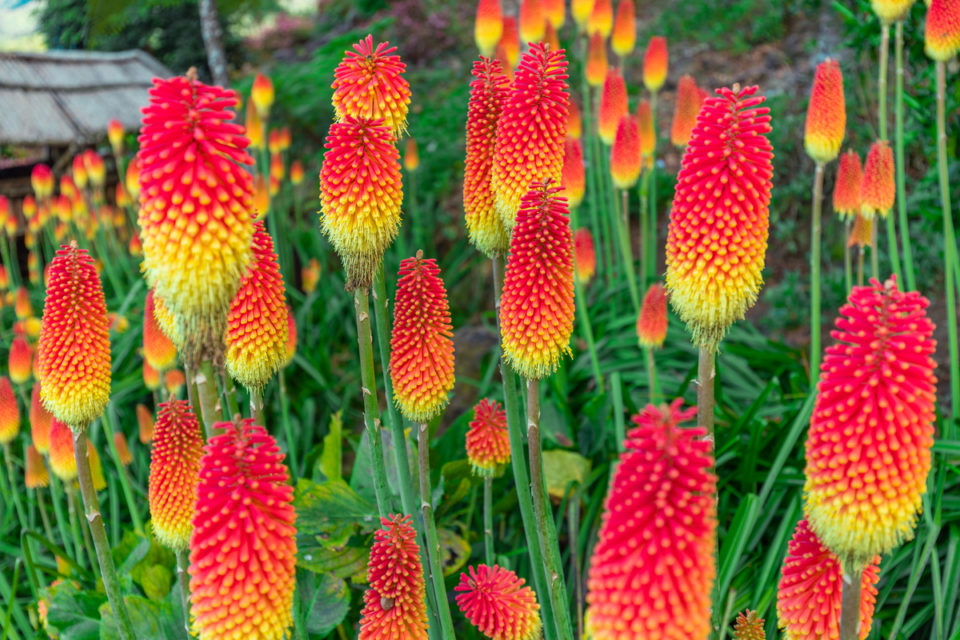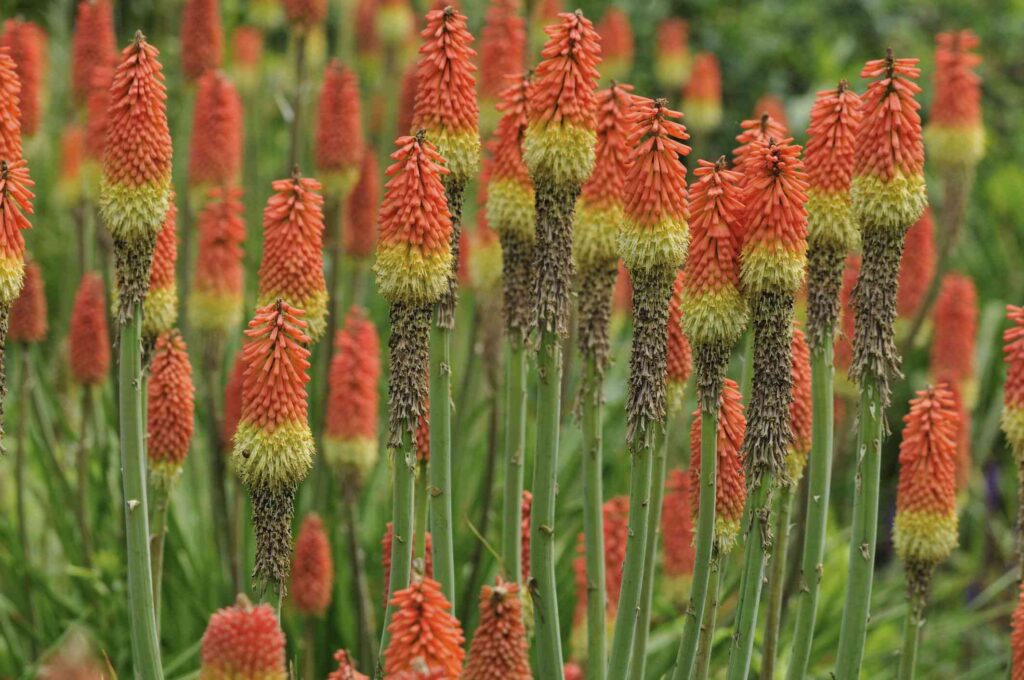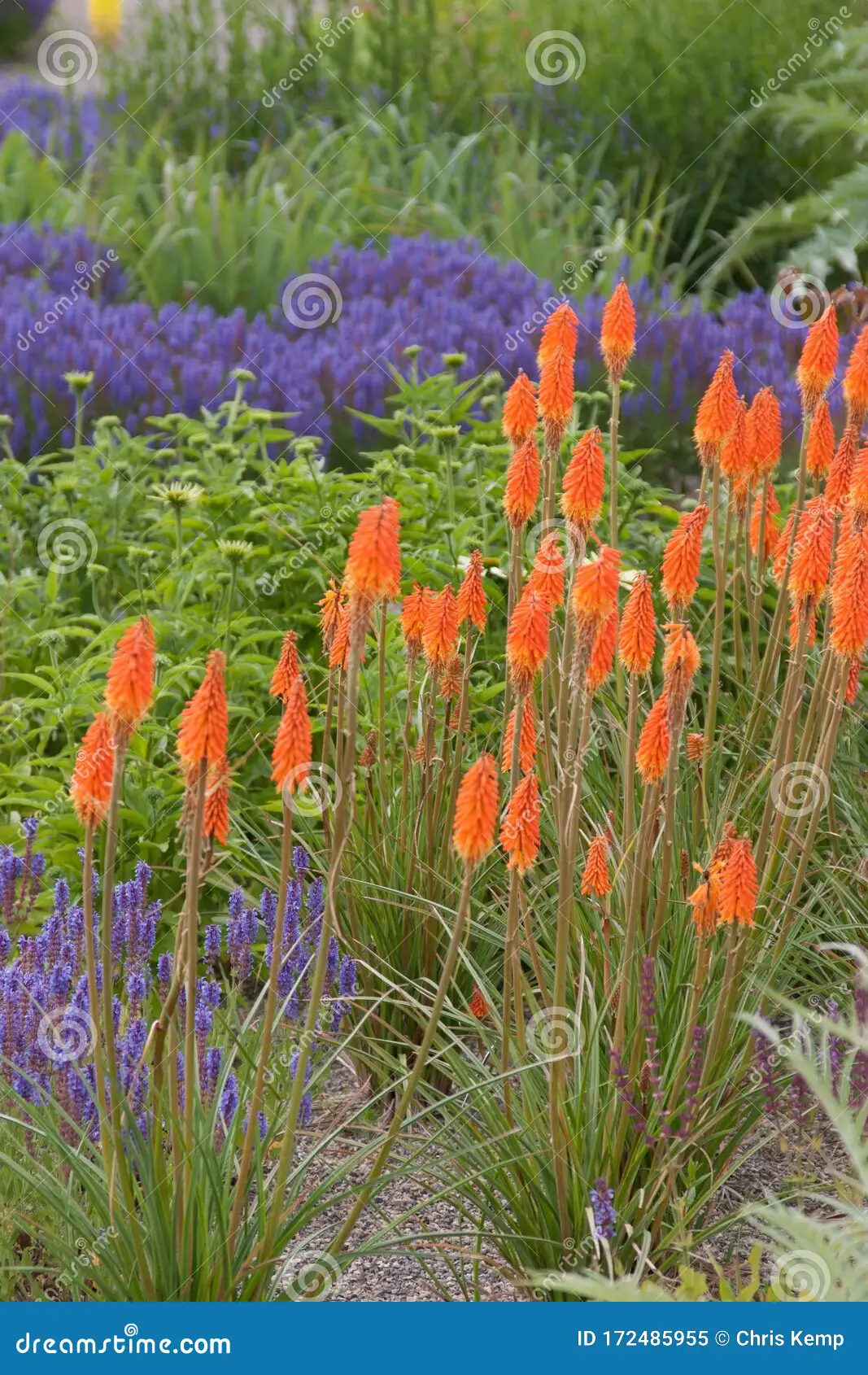
I love and adore pokers and so should every gardener. A poker filled garden is a mighty happy one. Few plants if any, can surpass the superb sculptural sword like foliage and statuesque tall stems of flowers rising a good two metres in height, with their illuminating flower torches of the richest and most vivid of colours. If you seek that sense bit of the real bling of the tropical and exotic, pokers are the ideal candidate.
Regrettably in recent years they have lost their previous widely planted popularity. Many turn their noses up at them, regarding them as a throwback to old time grannie gardens, common, course, too untidy, too brash and gaudy in colour, even downright ugly. Well, they are a whole lot of silly folks, who need to get out more.
I vividly remember in my more youthful years, a rich memory, never forgotten. We travelled slowly by car, along an unsealed long and winding country property road. It was fantastically flanked on both sides with hundreds even thousands of mature pokers ablaze in the brightest, most vivid and electric orange beacons of flowering pokers. The plantings seemed to continue endlessly for many kilometers. I was very glad of our slow pace for I was totally in awe of the massed spectacle and it gave me the invaluable time to fully appreciate it all. When we finally arrived at the country homestead, I was one very happy fellow.
Whoever had the idea to plant such a brave and adventurous long and extended stunning floral spectacle should be very well thanked and congratulated, and indeed their name never forgotten.

History
The genus was named after the German Johann Hieronymus Kniphof a professor of medicine and botany, (1704 – 1765). They originated in warm and tropical areas of Central and Southern Africa, Ethiopia and Madagascar.
The botanical name Knipholia is at first reading practically unpronounceable. People are so uncertain in how to pronounce it, that is most probably why the common name red hot pokers are so universally known by. To correctly pronounce its botanical name, try this; the ‘k’ is silent, the ‘i’ becomes an ‘e’ as in knee, the second ‘I’ also becomes an ‘e’ and then it should be a melodic ‘nee-foe-lee-ah. However, I may well be a little touched for I never seem to remember this correct pronunciation even after 40 years of planting them.
Varieties
Today the majority of pokers grown are modern hybrids sporting a much wider range of colours, from the usual orange and red, to the newer green, lime, yellow and cream flowers. The newer hybrid trends are for more diminutive plants in both foliage and flower stems, but call me a traditionalist, I much prefer the original taller varieties for their greater visual impact. My eternal favourite is ‘Winter Cheer’ which does not ever shut up flowering from winter through to the near middle of spring.
Cultivation
Pokers are essentially warm climate plants and are one of the great survivors. They are impervious to the longest of droughts and the hardest of winter frosts. They will grow in practically any soil, revel in positions that other plants will not, though a reasonably well drained soil is preferred. They adore a position in full sun, the more the better, but with too much shade they are reluctant to flower. Like other drought tolerant plants, they will survive well enough without water, but consistent rain or home watering will increase its proliferation and performance exponentially. If you have the blessing of a wet summer, then their glory will be even more stellar.
A simple hard haircut to a height of 0.5 to 1metre once a year is all it needs. Before the pruning back, add generous layers of Seamungus and Rooster Booster around its base and leaved circumference area, water in well, and then the fallen pruned back leaves will act as mulch for the coming year.

Design
A more modern successful design planting is located at my local university gym. The position of the building is cut deep into a huge hill, creating to the north a large and expansive sharply sloped garden bed, about 10 metres in width and 3 metres in depth. It is populated by only three plants planted en masse, pokers, white agapanthus and the grevillea groundcover Bronze Rambler. In its simplicity and visual beauty it is just stunning.
Propagation
Propagation is most successfully achieved by root division, preferably in spring, either by the young side growths or splitting apart the whole plant. An established mature plant has a massive root system, so good luck with that.
My research suggests pokers can hybridise quite readily. It is quite difficult to recreate new and true plants from the seeds of parent stock. If sown from seed the plants will flower in the second year. At times they can self-sow, though not often.
Pokers should be a mandatory planting in all gardens. If you possess a small garden and are limited in space, thankfully a single planting of pokers will still bring you and your garden great happiness.
Happy gardening and have fun,
Regards Ned McDowell.